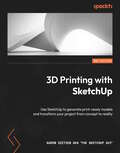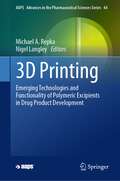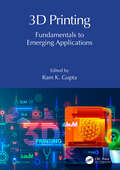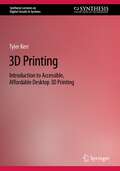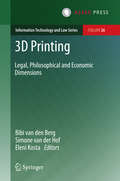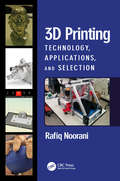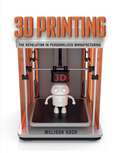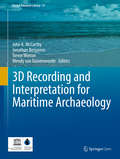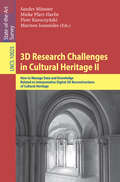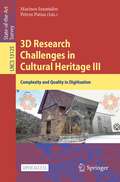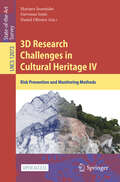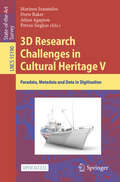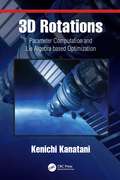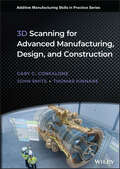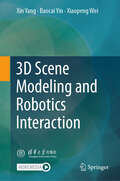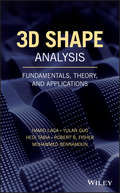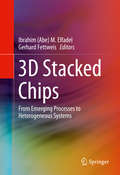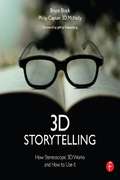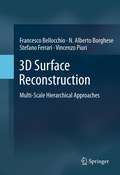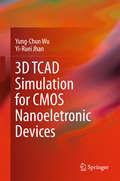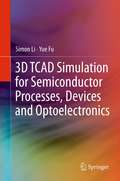- Table View
- List View
3D Printing with SketchUp
by Marcus RitlandThis book is a practical tutorial, packed with real-world case studies to help you design models that print right the first time. If you are familiar with SketchUp and want to print the models you've designed, then this book is ideal for you. You don't need any experience in 3D printing; however, SketchUp beginners will require a companion book or video training series to teach them the basic SketchUp skills.
3D Printing with SketchUp: Use SketchUp to generate print-ready models and transform your project from concept to reality, 2nd Edition
by Aaron Dietzen aka 'The SketchUp Guy'Create stunning 3D print-ready models quickly and easily using any version of SketchUpPurchase of the print or Kindle book includes a free PDF eBookKey FeaturesFind out how to use SketchUp Free, Go, or Pro to create print-ready modelsWork through clearly illustrated examples to learn just how to design for 3D printingModel multiple pieces that can be assembled post-printBook DescriptionWorking with the amazing 3D printing technology and getting access to the printing hardware is now easier than ever before. While there are many other resources that cover the general process of 3D printing, this book is the ultimate guide to creating models for 3D printing using SketchUp.You'll start with a basic understanding of how SketchUp is used in the 3D printing workflow and jump into the steps to create a print-ready model using only SketchUp. This 3D printing book will guide you in using SketchUp to modify existing 3D files and cover additional tools that make SketchUp an even more powerful modeling tool. As you advance, you'll learn how to transform 2D images into 3D printable solids, how to create multi-part prints that can be assembled without the use of fasteners or glue, and how to make sure your model, whether designed from scratch or assembled from preexisting geometry, is ready to be made real via your 3D printer.By the end of this book, you'll have the confidence to bring your design ideas to life by generating your own 3D print-ready models with SketchUp.What you will learnUnderstand SketchUp's role in the 3D printing workflowGenerate print-ready geometry using SketchUpImport existing files for editing in SketchUpVerify whether a model is ready to be printed or notModel from a reference object and use native editing toolsExplore the options available for adding onto SketchUp for the purpose of 3D printing (extensions)Understand the steps to export a file from SketchUpWho this book is forIf you own or have access to a 3D printer and are tired of downloading and printing other people's 3D models, this book is for you! Learn how to use SketchUp to create your own custom pieces or modify existing files so you can print exactly what you need. Whether you are an architect hoping to print buildings, a designer needing quick physical prototypes, or a hobbyist wanting to print a tchotchke, this book is for you. Readers should have completed some training in fundamentals in SketchUp and be able to create and edit basic geometry.
3D Printing: Emerging Technologies and Functionality of Polymeric Excipients in Drug Product Development (AAPS Advances in the Pharmaceutical Sciences Series #44)
by Michael A. Repka Nigel LangleyThis inclusive text describes 3D Printing for pharmaceutical applications, including emerging 3D technologies. The book focuses on the functionality of the materials/biomaterials used for the preparation of dosage forms and devices, fundamentals for preparing these systems and novel applications using these additive manufacturing techniques. Also, the text includes clinical relevance and regulatory considerations for the future of personalized medicine.Authored by experts with a broad range of experience, extensive insight into the science of 3D printing technology used to produce these systems is provided. Highlighting viewpoints from the academic, polymer excipient, equipment, product development and regulatory communities, this comprehensive text compiles input from industry thought leaders to illustrate strategies and technologies for applying techniques of additive manufacturing for drug product and device development while also providing insight into the path forward for the technology in years to come.
3D Printing: Fundamentals to Emerging Applications
by Ram K Gupta3D Printing: Fundamentals to Emerging Applications discusses the fundamentals of 3D-printing technologies and their emerging applications in many important sectors such as energy, biomedicals, and sensors. Top international authors in their fields cover the fundamentals of 3D-printing technologies for batteries, supercapacitors, fuel cells, sensors, and biomedical and other emerging applications. They also address current challenges and possible solutions in 3D-printing technologies for advanced applications. Key features: Addresses the state-of-the-art progress and challenges in 3D-printing technologies Explores the use of various materials in 3D printing for advanced applications Covers fundamentals of the electrochemical behavior of various materials for energy applications Provides new direction and enables understanding of the chemistry, electrochemical properties, and technologies for 3D printing This is a must-have resource for students as well as researchers and industry professionals working in energy, biomedicine, materials, and nanotechnology.
3D Printing: Introduction to Accessible, Affordable Desktop 3D Printing (Synthesis Lectures on Digital Circuits & Systems)
by Tyler KerrThis book is an introduction to the wide and varied world of 3D printing—an incredible technology used across an ever-growing list of industries. As 3D printing continues to skyrocket in popularity, it’s increasingly important to understand how these machines work and how to apply 3D printing technology to personal and professional interests. More important still, this book highlights how surprisingly easy 3D printers can be to use, even for readers who don’t consider themselves particularly tech-savvy. This book provides a comprehensive overview of 3D printing for first-time users. The text introduces some of the most popular types of 3D printing technology available, as well as some of the most exciting and compelling applications across industry today. The content dives deeply into one of the most popular and widely accessible 3D print technology on the market: fused deposition modeling (FDM) 3D printing. The reader will learn basic FDM 3D printer anatomy, software settings, as well as the tips and tricks to master your own FDM 3D printer. The book provides a firm understanding of what FDM 3D printing excels at, its current limitations, and how to troubleshoot and overcome some of the most common 3D printing problems. The book then provides some ‘STEAM-building’ cross-disciplinary challenges and applications for the reader to complete at home. This book is for novice readers who might be early in their 3D printing journey. For those looking to learn more about introductory 3D printing and curious about how to get started, this is an excellent place to start. By the end of the book, the reader should have all the understanding and tools necessary to start 3D printing with confidence.
3D Printing: Legal, Philosophical and Economic Dimensions (Information Technology and Law Series #26)
by Eleni Kosta Simone van der Hof Bibi van den BergThe book in front of you is the first international academic volume on the legal, philosophical and economic aspects of the rise of 3D printing. In recent years 3D printing has become a hot topic. Some claim that it will revolutionize production and mass consumption, enabling consumers to print anything from clothing, automobile parts and guns to various foods, medication and spare parts for their home appliances. This may significantly reduce our environmental footprint, but also offers potential for innovation and creativity. At the same time 3D printing raises social, ethical, regulatory and legal questions. If individuals can print anything they want, how does this affect existing systems of intellectual property rights? What are the societal consequences of the various types of products one can print with a 3D printer, for example weapons? Should all aspects of 3D printing be regulated, and if so, how and to what ends? How will businesses (have to) change their way of working and their revenue model in light of the shift to printing-on-demand? How will the role of product designers change in a world where everyone has the potential to design their own products? These and other questions are addressed in high quality and in-depth contributions by academics and experts, bringing together a wide variety of academic discussions on 3D printing from different disciplines as well as presenting new views, broadening the discussion beyond the merely technical dimension of 3D printing. Bibi van den Berg is Associate Professor at eLaw, the Center for Law and Digital Technologies at Leiden University, The Netherlands. Simone van der Hof is Full Professor at eLaw in Leiden and Eleni Kosta is Associate Professor at TILT, the Tilburg Institute for Law, Technology and Society at Tilburg University, The Netherlands.
3D Printing: Technology, Applications, and Selection
by Rafiq Noorani3D Printing is a faster, more cost-effective method for building prototypes from three-dimensional computer-aided design (CAD) drawings. 3D Printing provides a fundamental overview of the general product design and manufacturing process and presents the technology and application for designing and fabricating parts in a format that makes learning easy. This user-friendly book clearly covers the 3D printing process for designers, teachers, students, and hobbyists and can also be used as a reference book in a product design and process development.
3D Printing: The Revolution in Personalized Manufacturing
by Melissa Koch3D printing was once only known through science fiction, such as Star Trek, the popular 1960s TV series. But inventors and engineers on Earth began experimenting in real life with 3D printing to find faster ways to develop and build prototypes, using computers, ultraviolet lasers, and printable materials. Now, there are many innovative uses for 3D printing. Yet 3D printing has drawbacks. Chemicals used in 3D printing can be toxic, and legal experts are not sure how to protect 3D printing inventions so that others do not steal ideas. Learn how 3D printing works and how we can keep up with the safety, health, and legal challenges that lie ahead.
3D Programming for Windows®
by Charles PetzoldGet a focused introduction to programming 3D graphics with the Windows Presentation Foundation 3D API. Complementing his book Applications = Code + Markup, award-winning author Charles Petzold builds on XAML essentials, teaching you how to display and animate 3D graphics under the Microsoft .NET Framework 3.0 and Windows Vista. You'll get expert guidance and code samples in XAML and Microsoft Visual C#-- helping you master the skills you need to create high-fidelity user interfaces. Discover how to: Define complex 3D objects with triangle meshes Enhance the illumination of 3D surfaces with light and shading effects Color 3D figures with gradients, bitmaps, and drawings Add animation with transforms and vertex manipulation Represent linear, affine, and camera transforms by using matrices Calculate vector angles, angles of rotation, and axes of rotation Generate triangle meshes efficiently by using C# code Express rotation by using quaternion computation Provide a user interface for manipulating and drawing 3D figures PLUS--Get Visual C# and XAML code samples on the Web
3D Recording and Interpretation for Maritime Archaeology (Coastal Research Library #31)
by Jonathan Benjamin John K. McCarthy Trevor Winton Wendy Van DuivenvoordeThis open access peer-reviewed volume was inspired by the UNESCO UNITWIN Network for Underwater Archaeology International Workshop held at Flinders University, Adelaide, Australia in November 2016. Content is based on, but not limited to, the work presented at the workshop which was dedicated to 3D recording and interpretation for maritime archaeology. The volume consists of contributions from leading international experts as well as up-and-coming early career researchers from around the globe. The content of the book includes recording and analysis of maritime archaeology through emerging technologies, including both practical and theoretical contributions. Topics include photogrammetric recording, laser scanning, marine geophysical 3D survey techniques, virtual reality, 3D modelling and reconstruction, data integration and Geographic Information Systems. The principal incentive for this publication is the ongoing rapid shift in the methodologies of maritime archaeology within recent years and a marked increase in the use of 3D and digital approaches. This convergence of digital technologies such as underwater photography and photogrammetry, 3D sonar, 3D virtual reality, and 3D printing has highlighted a pressing need for these new methodologies to be considered together, both in terms of defining the state-of-the-art and for consideration of future directions. As a scholarly publication, the audience for the book includes students and researchers, as well as professionals working in various aspects of archaeology, heritage management, education, museums, and public policy. It will be of special interest to those working in the field of coastal cultural resource management and underwater archaeology but will also be of broader interest to anyone interested in archaeology and to those in other disciplines who are now engaging with 3D recording and visualization.
3D Research Challenges in Cultural Heritage II: How to Manage Data and Knowledge Related to Interpretative Digital 3D Reconstructions of Cultural Heritage (Lecture Notes in Computer Science #10025)
by Sander Münster Mieke Pfarr-Harfst Piotr Kuroczyński Marinos IoannidesThis book reflects a current state of the art and future perspectives of Digital Heritage focusing on not interpretative reconstruction and including as well as bridging practical and theoretical perspectives, strategies and approaches. Comprehensive key challenges are related to knowledge transfer and management as well as data handling within a interpretative digital reconstruction of Cultural Heritage including aspects of digital object creation, sustainability, accessibility, documentation, presentation, preservation and more general scientific compatibility. The three parts of the book provide an overview of a scope of usage scenarios, a current state of infrastructures as digital libraries, information repositories for an interpretative reconstruction of Cultural Heritage; highlight strategies, practices and principles currently used to ensure compatibility, reusability and sustainability of data objects and related knowledge within a 3D reconstruction work process on a day to day work basis; and show innovative concepts for the exchange, publishing and management of 3D objects and for inherit knowledge about data, workflows and semantic structures.
3D Research Challenges in Cultural Heritage III: Complexity and Quality in Digitisation (Lecture Notes in Computer Science #13125)
by Marinos Ioannides Petros PatiasThis open access book presents a collection of papers focusing on current 3D research challenges in the domain of digital cultural heritage. 3D technologies find considerable use within the field of cultural heritage at the beginning of the 21st century, for example in the areas of data acquisition, modeling, archiving in local repositories, harvesting in digital libraries and their long-term preservation. This volume put emphasis on a number of challenges facing 3D research in the 2D/3D digitization of tangible objects and their transformation to digital/virtual/memory twins; the interplay of geometry, semantics and the recovery and management of knowledge in digital cultural heritage; the handling of 3D data via the Cloud on the Internet and mobile devices; the presentation of cultural heritage content in 3D to the general public; and the 3D reproduction of cultural heritage objects from virtual to real.
3D Research Challenges in Cultural Heritage IV: Risk Prevention and Monitoring Methods (Lecture Notes in Computer Science #13577)
by Marinos Ioannides Daniel Oliveira Giovanni IssiniThis open access book presents a collection of papers focusing on a range of digital technologies and their use in the protection and restoration of cultural heritage. Digital tools - from 3D scanning and photogrammetry to Heritage Building Information Modeling (HBIM), Digital Twins, and Extended Reality (XR) - are transforming the way we understand and care for tangible heritage. These technologies are applied to both record the physical form and material conditions of a site and to permit simulations of deterioration, design interventions, and careful reconstruction. A central theme of this volume is post-disaster restoration and how the scientific and technical aspects of restoration can be made accessible to a broader audience through innovative visualizations, interactive platforms and storytelling. Digital tools should not only serve experts but also allow the public to participate both on-site and remotely via the web. This book advocates a holistic approach to heritage management, combining cutting-edge technology with local knowledge, risk analysis with creative reuse, and positioning the act of restoration as a bridge connecting the past, present and future.
3D Research Challenges in Cultural Heritage V: Paradata, Metadata and Data in Digitisation (Lecture Notes in Computer Science #15190)
by Marinos Ioannides Athos Agapiou Drew Baker Petros SiegkasThis open access book presents a collection of papers focussing on 3D digitisation in the domain of cultural heritage. The use of data acquisition technologies in digitising cultural heritage holds great potential for preserving and disseminating the history of mankind. However, to exploit these opportunities in full, comprehensive guidelines for documenting the process of digitisation are required. Only then can the efficiency and credibility of digital representations be assured. A major focus of the 16 papers included in this State-of-the-Art Survey is on all aspects of the documentation of the digitisation process, i.e., the paradata, which, alongside the metadata, is critical to the scientific rigour, replicability and sustainability of digital heritage resources. The volume provides a useful resource for computer scientists, surveyors, archaeologists, architects, museologists and engineers.
3D Rotations: Parameter Computation and Lie Algebra based Optimization
by Kenichi Kanatani3D rotation analysis is widely encountered in everyday problems thanks to the development of computers. Sensing 3D using cameras and sensors, analyzing and modeling 3D for computer vision and computer graphics, and controlling and simulating robot motion all require 3D rotation computation. This book focuses on the computational analysis of 3D rotation, rather than classical motion analysis. It regards noise as random variables and models their probability distributions. It also pursues statistically optimal computation for maximizing the expected accuracy, as is typical of nonlinear optimization. All concepts are illustrated using computer vision applications as examples. Mathematically, the set of all 3D rotations forms a group denoted by SO(3). Exploiting this group property, we obtain an optimal solution analytical or numerically, depending on the problem. Our numerical scheme, which we call the "Lie algebra method," is based on the Lie group structure of SO(3). This book also proposes computing projects for readers who want to code the theories presented in this book, describing necessary 3D simulation setting as well as providing real GPS 3D measurement data. To help readers not very familiar with abstract mathematics, a brief overview of quaternion algebra, matrix analysis, Lie groups, and Lie algebras is provided as Appendix at the end of the volume.
3D Scanning for Advanced Manufacturing, Design, and Construction: Metrology For Advanced Manufacturing (Additive Manufacturing Skills in Practice.)
by Gary C. Confalone John Smits Thomas Kinnare3D Scanning for Advanced Manufacturing, Design, and Construction Learn how 3D scanning technology drives advanced manufacturing and modern construction 3D scanning technology allows non-contact scanning of objects for unprecedented data collection, analysis, and modeling. 3D models created this way are valuable at every stage of the design and build process and they have become a staple in additive manufacturing or 3D printing. As 3D printing transforms global industry at every scale, there has never been a better time for engineers and industrial professionals to be competitive in the area of 3D scanning, a multibillion-dollar market that continues to grow. 3D Scanning Technology for Advanced Manufacturing, Design, and Construction provides a comprehensive introduction to 3D scanning and its applications in both the AEC and manufacturing industries. After establishing the history and basic principles of 3D scanning, it includes discussions of the various scanner types and software interfaces, the use of 3D point clouds for analysis and reverse engineering, and much more. It covers the full range of technology and processes that engineers, architects, and manufacturing professionals use to increase accuracy and quality while reducing project timelines. Readers of 3D Scanning Technology for Advanced Manufacturing, Design, and Construction will also find: Case studies that highlight techniques useful for specific real-world applications Comparisons of various scanning devices and software that aid in choosing the proper technologies for a specific project Resources and references for online learning, organizations, and certifications Perfect for engineers, technicians, students, and industry professionals new to laser scanning, 3D Scanning Technology for Advanced Manufacturing, Design, and Construction will earn its place in libraries of technical, vocational, and continuing education audiences seeking to improve their knowledge of 3D scanning.
3D Scene Modeling and Robotics Interaction
by Xin Yang Baocai Yin Xiaopeng WeiThis book focuses on the intelligent perception and interaction module in intelligent robotic systems, establishes a multidisciplinary cross-fertilization knowledge system, explores the related technology frontiers and research frontiers as comprehensively as possible from the perspective of scene modeling and understanding, and develops a practical exposition of practical application tasks such as robotic navigation, obstacle avoidance, and grasping. The main contents of this book include 3D reconstruction, scene exploration, scene understanding, robot navigation and obstacle avoidance, robot grasping and comprehensive project practice. Combining theory and practice, the book contains both basic algorithms and covers the latest technologies with detailed code or pseudo-code resources. This book can be used as a teaching reference book for information and intelligence related majors in higher education institutions, computer graphics, computer vision and intelligent robotics and other related fields, as well as a reference book for technicians engaged in related fields. This book takes intelligent robots as the carrier, focuses on the technologies of environment perception and understanding and applying them to practical tasks such as robot navigation, obstacle avoidance and grasping. The book consists of six chapters. Chapters 1 to 3 provide a comprehensive introduction to the development and application of scene modeling and understanding technologies, including 3D reconstruction, scene exploration, and scene understanding. Chapters 4 and Chapter 5 provide a comprehensive introduction to the development and application of robot perception technologies, including visual relocalization and robot navigation, obstacle avoidance and grasping. Chapter 6 introduces comprehensive project practice with 3D scene modeling and understanding for robot tasks as an example, which facilitates readers to have a comprehensive understanding and mastery of theory and practice. The translation was done with the help of artificial intelligence. A subsequent human revision was done primarily in terms of content.
3D Shape Analysis: Fundamentals, Theory, and Applications
by Robert B. Fisher Mohammed Bennamoun Hamid Laga Yulan Guo Hedi TabiaAn in-depth description of the state-of-the-art of 3D shape analysis techniques and their applications This book discusses the different topics that come under the title of "3D shape analysis". It covers the theoretical foundations and the major solutions that have been presented in the literature. It also establishes links between solutions proposed by different communities that studied 3D shape, such as mathematics and statistics, medical imaging, computer vision, and computer graphics. The first part of 3D Shape Analysis: Fundamentals, Theory, and Applications provides a review of the background concepts such as methods for the acquisition and representation of 3D geometries, and the fundamentals of geometry and topology. It specifically covers stereo matching, structured light, and intrinsic vs. extrinsic properties of shape. Parts 2 and 3 present a range of mathematical and algorithmic tools (which are used for e.g., global descriptors, keypoint detectors, local feature descriptors, and algorithms) that are commonly used for the detection, registration, recognition, classification, and retrieval of 3D objects. Both also place strong emphasis on recent techniques motivated by the spread of commodity devices for 3D acquisition. Part 4 demonstrates the use of these techniques in a selection of 3D shape analysis applications. It covers 3D face recognition, object recognition in 3D scenes, and 3D shape retrieval. It also discusses examples of semantic applications and cross domain 3D retrieval, i.e. how to retrieve 3D models using various types of modalities, e.g. sketches and/or images. The book concludes with a summary of the main ideas and discussions of the future trends. 3D Shape Analysis: Fundamentals, Theory, and Applications is an excellent reference for graduate students, researchers, and professionals in different fields of mathematics, computer science, and engineering. It is also ideal for courses in computer vision and computer graphics, as well as for those seeking 3D industrial/commercial solutions.
3D Sponge-Matrix Histoculture: Methods And Protocols (Methods In Molecular Biology #1760)
by Robert M. HoffmanThis volume describes numerous applications of sponge-matrix histoculture to study cancer biology and the treatment of cancer, stem cells, organoids, growth and repair of nerves, lymphoid tissues that produce antibodies, and HIV infection. The chapters in this book cover topics including, in vivo-like growth patterns of multiple types of tumors in Gelfoam® histoculture; development of the histoculture drug response assay (HDRA) for cancer patients; hair-shaft growth in Gelfoam® histoculture of skin as well as isolated hair follicles in Gelfoam® histoculture; the use of Gelfoam® histoculture to discover novel treatment of HIV infection; and imaging DNA repair after UV irradiation damage of cancer cells in Gelfoam® histoculture. The volume explains what is true 3D cell and tissue culture and corrects widespread misconceptions of 3D culture in the literature. Written in the highly successful Methods in Molecular Biology series format, chapters include introductions to their respective topics, lists of the necessary materials and reagents, step-by-step, readily reproducible laboratory protocols, and tips on troubleshooting and avoiding known pitfalls. <p><p> Cutting–edge and authoritative, 3D Sponge-Matrix Histoculture: Methods and Protocols is a valuable resource that contributes to new cell and tissue culture research, and other diseases based on the true 3D culture.
3D Stacked Chips: From Emerging Processes to Heterogeneous Systems
by Ibrahim Abe M. Elfadel Gerhard FettweisThis book explains for readers how 3D chip stacks promise to increase the level of on-chip integration, and to design new heterogeneous semiconductor devices that combine chips of different integration technologies (incl. sensors) in a single package of the smallest possible size. The authors focus on heterogeneous 3D integration, addressing some of the most important challenges in this emerging technology, including contactless, optics-based, and carbon-nanotube-based 3D integration, as well as signal-integrity and thermal management issues in copper-based 3D integration. Coverage also includes the 3D heterogeneous integration of power sources, photonic devices, and non-volatile memories based on new materials systems.
3D Storytelling: How Stereoscopic 3D Works and How to Use It
by Bruce Block Philip Mcnally3D Storytelling is the ultimate guide for directors, cinematographers, producers, and designers of stereoscopic 3D movies and videos. With an emphasis on the aesthetic over the technical, this book is an essential foundation for showing you how to use 3D creatively to tell a story. Hollywood producer Bruce Block and Dreamworks stereoscopic supervisor Philip Captain 3D McNally blend their vast real-world experience and teaching skills to help you learn how to:* Think in 3D* Integrate 3D design into your script or story* Direct and design the 3D depth of your shots* Use stereoscopic windows* Work with the depth cues in 3D* Create a comfortable viewing experience for the audience* Plan editing and directorial considerations for 3D* Understand closed, open, and unstable 3D spaceBrimming with practical information that can be immediately applied to your 3D production, the book also features interviews with some of the industry’s leading stereographers, as well as 3D diagrams and photographs that illustrate how 3D works, how it can be controlled in production, and how 3D can be used to tell a story.
3D Surface Reconstruction: Multi-Scale Hierarchical Approaches
by Vincenzo Piuri Francesco Bellocchio N. Alberto Borghese Stefano Ferrari3D Surface Reconstruction: Multi-Scale Hierarchical Approaches presents methods to model 3D objects in an incremental way so as to capture more finer details at each step. The configuration of the model parameters, the rationale and solutions are described and discussed in detail so the reader has a strong understanding of the methodology. Modeling starts from data captured by 3D digitizers and makes the process even more clear and engaging. Innovative approaches, based on two popular machine learning paradigms, namely Radial Basis Functions and the Support Vector Machines, are also introduced. These paradigms are innovatively extended to a multi-scale incremental structure, based on a hierarchical scheme. The resulting approaches allow readers to achieve high accuracy with limited computational complexity, and makes the approaches appropriate for online, real-time operation. Applications can be found in any domain in which regression is required. 3D Surface Reconstruction: Multi-Scale Hierarchical Approaches is designed as a secondary text book or reference for advanced-level students and researchers in computer science. This book also targets practitioners working in computer vision or machine learning related fields.
3D Systems
by David Lane Karim R. LakhaniIn late 2013, Rajeev Kulkarni needed to decide how best to facilitate the emergence of a broad base of users and content to promote the sale of 3D Systems's consumer-focused 3D printers. As yet, neither the company nor users had identified an indispensable application for 3D printing for consumers, despite a plethora of potential opportunities.
3D TCAD Simulation for CMOS Nanoeletronic Devices
by Yung-Chun Wu Yi-Ruei JhanThis book demonstrates how to use the Synopsys Sentaurus TCAD 2014 version for the design and simulation of 3D CMOS (complementary metal-oxide-semiconductor) semiconductor nanoelectronic devices, while also providing selected source codes (Technology Computer-Aided Design, TCAD). Instead of the built-in examples of Sentaurus TCAD 2014, the practical cases presented here, based on years of teaching and research experience, are used to interpret and analyze simulation results of the physical and electrical properties of designed 3D CMOSFET (metal-oxide-semiconductor field-effect transistor) nanoelectronic devices. The book also addresses in detail the fundamental theory of advanced semiconductor device design for the further simulation and analysis of electric and physical properties of semiconductor devices. The design and simulation technologies for nano-semiconductor devices explored here are more practical in nature and representative of the semiconductor industry, and as such can promote the development of pioneering semiconductor devices, semiconductor device physics, and more practically-oriented approaches to teaching and learning semiconductor engineering. The book can be used for graduate and senior undergraduate students alike, while also offering a reference guide for engineers and experts in the semiconductor industry. Readers are expected to have some preliminary knowledge of the field.
3D TCAD Simulation for Semiconductor Processes, Devices and Optoelectronics
by Suihua Li Simon LiTechnology computer-aided design, or TCAD, is critical to today's semiconductor technology and anybody working in this industry needs to know something about TCAD. This book is about how to use computer software to manufacture and test virtually semiconductor devices in 3D. It brings to life the topic of semiconductor device physics, with a hands-on, tutorial approach that de-emphasizes abstract physics and equations and emphasizes real practice and extensive illustrations. Coverage includes a comprehensive library of devices, representing the state of the art technology, such as SuperJunction LDMOS, GaN LED devices, etc.

